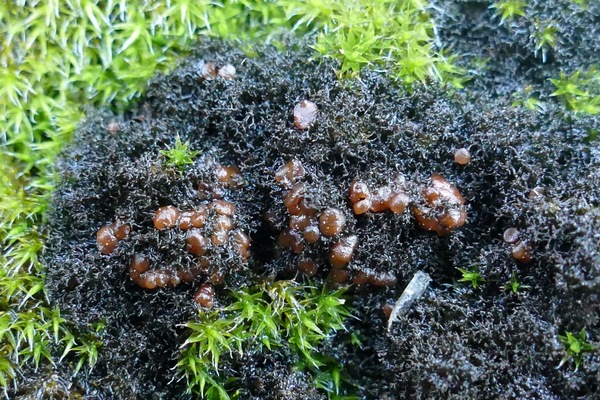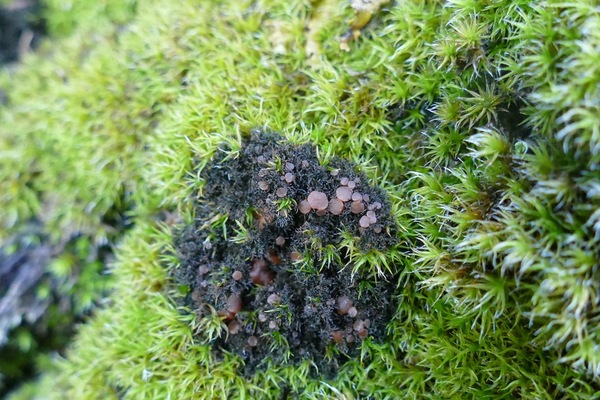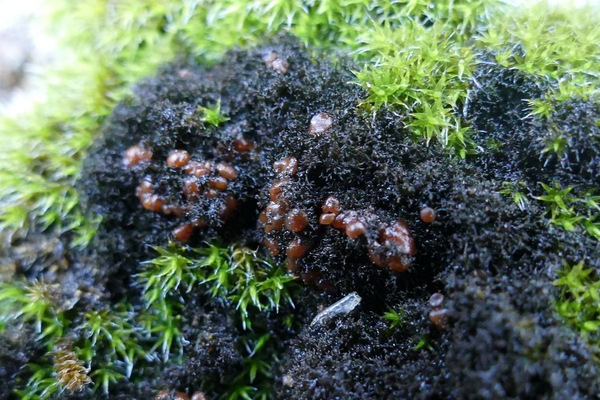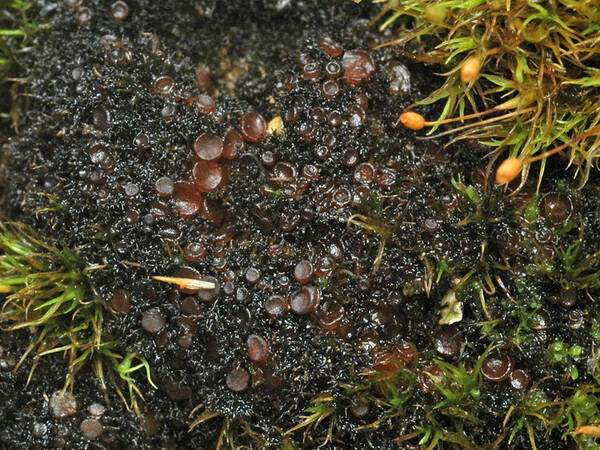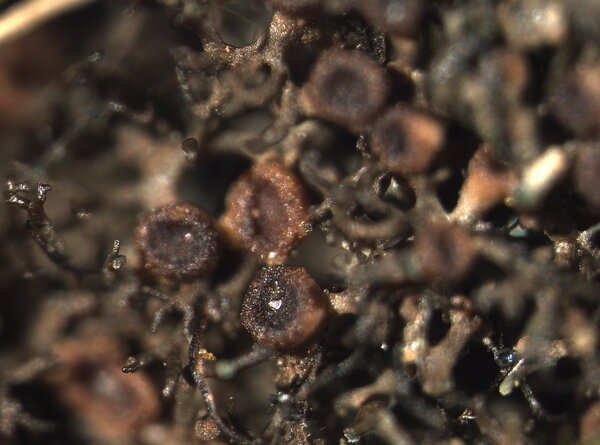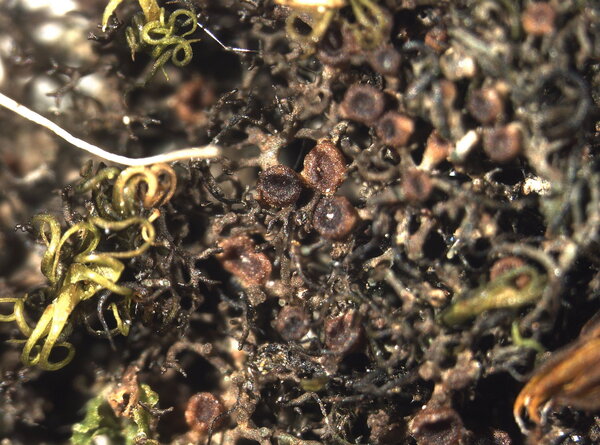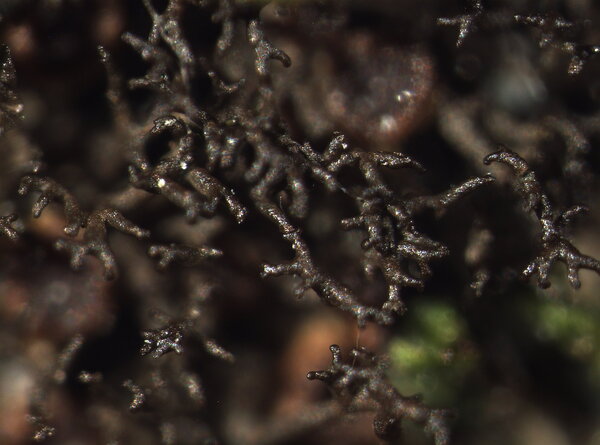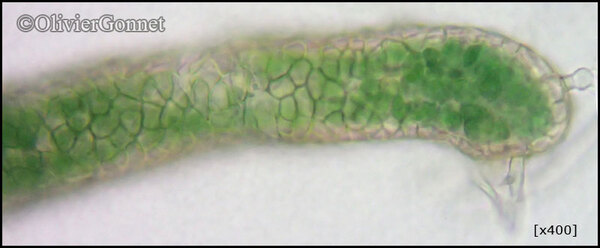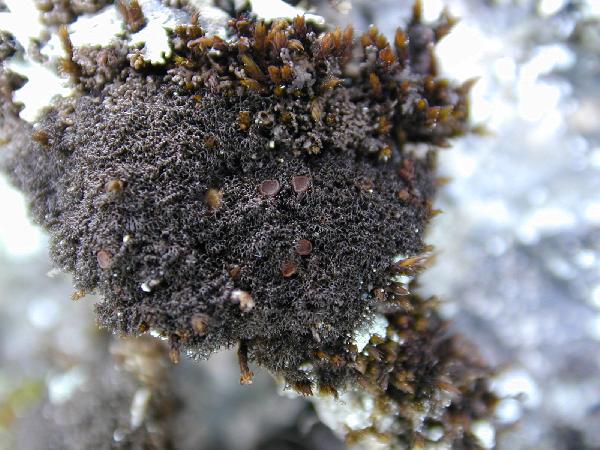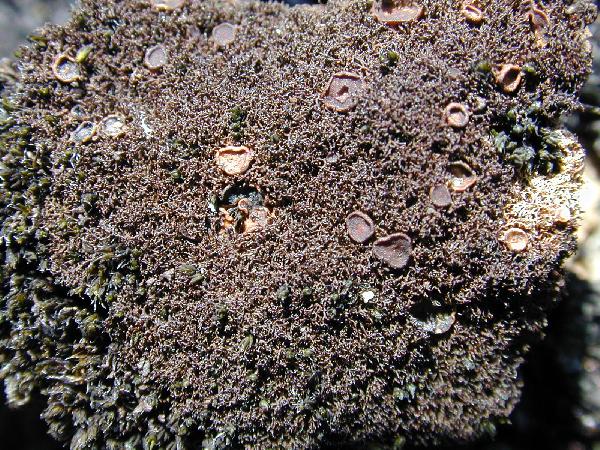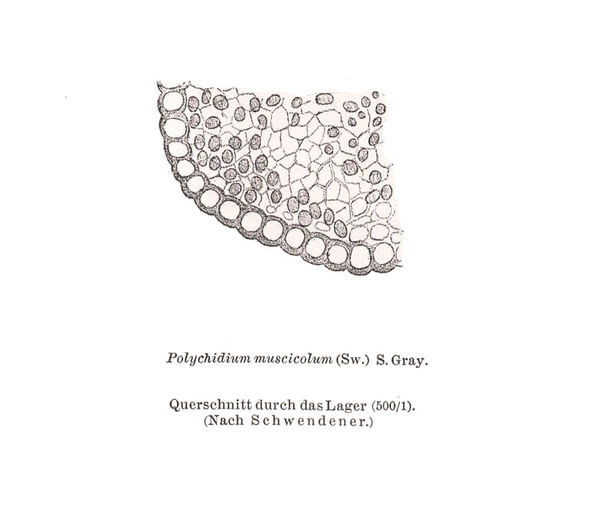Polychidium muscicola (Sw.) Gray
Nat. Arrang. Brit. Pl.: 402, 1821. Basionym: Lichen muscicola Sw. - N. Acta Reg. Soc. Sci. Upsal., 4: 248, 1784.
Synonyms: Collema muscicola (Sw.) Ach.; Homodium muscicola (Sw.) Nyl.; Leptogium muscicola (Sw.) Fr.; Polychidium kalkuense Räsänen
Distribution: N - Frl (Tretiach & Hafellner 2000), TAA (Nascimbene & al. 2022), Lomb (Gheza 2019), Piem (Isocrono & al. 2004), Emil (Fariselli & al. 2020), Lig. C - Sar. S - Camp (Aprile & al. 2003b), Cal (Puntillo 1996), Si (Grillo 1998, Grillo & Caniglia 2004).
Description: Thallus small-fruticose, filamentous, brown-black, glossy at least at the tip of young branches, forming loosely attached, small, up to 1.5 cm tall and up to 3 cm wide cushions. Branches smooth, slender, (40-)60-125(-200) µm thick, narrower toward the often nodulose apices, divergently and dichotomously or palmately divided, with a few, whitish rhizine-lke structures at the base. Cortex paraplectenchymatous, of 1-3 layers of polygonal cells; central part of thallus of loosely interwoven hyphae in young branches to almost paraplectenchymatous in old ones. Apothecia lateral, sessile and strongly constricted at base, up to 1.5(-2) mm across, with a red-brown, concave to flat disc and a rather thick, smooth, raised, somemehow paler, usually persistent proper margin. Proper exciple paraplectenchymatous, 60-75 µm wide; epithecium brownish; hymenium colourless, 85-110 µm high, I+ blue; paraphyses simple, 1-2 µm thick at mid-level, the apical cells swollen, up to 5 µm wide; hypothecium colourless to pale brown. Asci 8-spored, broadly cylindrical, the apices thickened with internal, amyloid sheets. Ascospores 1-septate, hyaline, sometimes weakly pigmented when old, spindle-shaped or ellipsoid (often within the same apothecium), (15-)18-25(-30) x (4.5-)5-7(-11) µm. Pycnidia dark, not common. Conidia hyaline, bacilliform, 1.5-3.5 x c. 1 µm. Photobiont cyanobacterial (Nostoc, the cells mostly in clusters, rarely in short chains). Spot tests: all negative. Chemistry: without lichen substances.Note: a widespread mild-temperate to southern boreal lichen found on soil and amongst bryophytes over siliceous substrata, more rarely on the basal parts of ancient trees, with a rather wide altitudinal range.
Growth form: Crustose
Substrata: soil, terricolous mosses, and plant debris
Photobiont: cyanobacteria, filamentous (e.g. Nostoc, Scytonema)
Reproductive strategy: mainly sexual
Most common in areas with a humid-warm climate (e.g. most of Tyrrenian Italy)
Commonnes-rarity: (info)
Alpine belt: absent
Subalpine belt: extremely rare
Oromediterranean belt: extremely rare
Montane belt: very rare
Submediterranean belt: extremely rare
Padanian area: absent
Humid submediterranean belt: very rare
Humid mediterranean belt: very rare
Dry mediterranean belt: absent
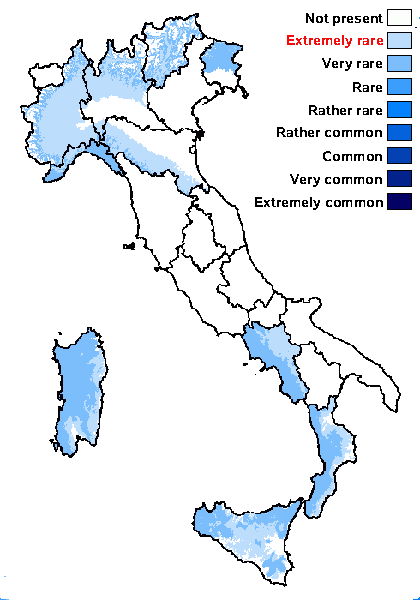
Predictive model
Herbarium samples
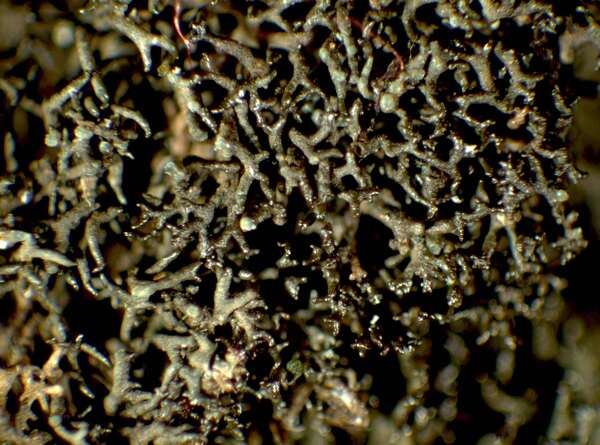

P.L. Nimis; Owner: Department of Life Sciences, University of Trieste
Herbarium: TSB (5166)
2001/11/28


P.L. Nimis; Owner: Department of Life Sciences, University of Trieste
Herbarium: TSB (5166)
2001/11/28
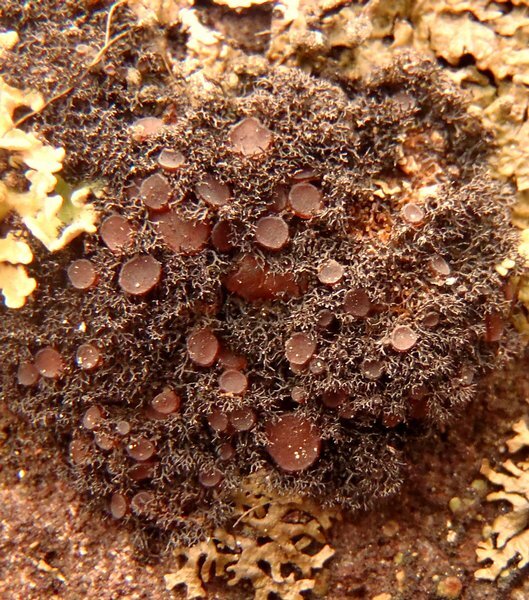

Curtis Randall Björk – CC BY-SA 4.0
British Columbia, Clearwater Valley Date: 2012-04-02 On basalt boulder in conifer-deciduous forest

Courtesy Danièle et Olivier Gonnet - Source: https://www.afl-lichenologie.fr/Photos_AFL/Photos_AFL_P/Text_P_3/Polychidium_muscicola.htm
France, 16/10/2012 - sur Grimmia - Quenza - Corse
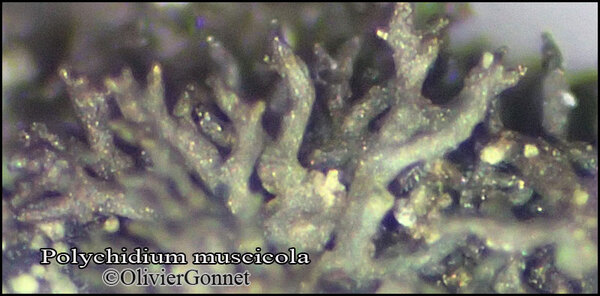
Courtesy Danièle et Olivier Gonnet - Source: https://www.afl-lichenologie.fr/Photos_AFL/Photos_AFL_P/Text_P_3/Polychidium_muscicola.htm
France, 28/12/2014 - session FMBDS - Mont Cenis - Savoie
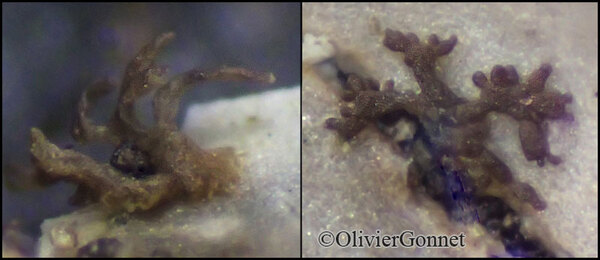
Courtesy Danièle et Olivier Gonnet - Source: https://www.afl-lichenologie.fr/Photos_AFL/Photos_AFL_P/Text_P_3/Polychidium_muscicola.htm
France, 4/11/2013 - Novacelles - sur Peltigera elisabethae établi sur mousse - Puy-de-Dôme
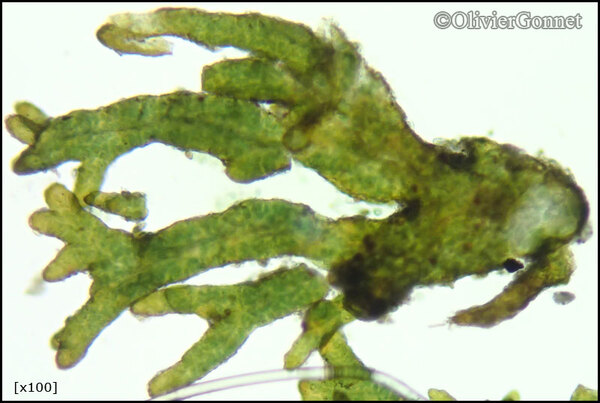
Courtesy Danièle et Olivier Gonnet - Source: https://www.afl-lichenologie.fr/Photos_AFL/Photos_AFL_P/Text_P_3/Polychidium_muscicola.htm
France, 4/11/2013 - Novacelles - sur Peltigera elisabethae établi sur mousse - Puy-de-Dôme
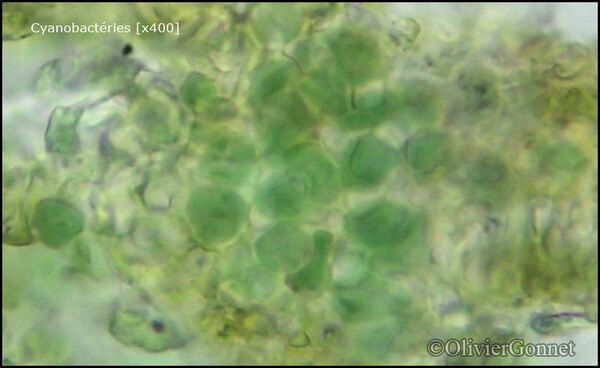
Courtesy Danièle et Olivier Gonnet - Source: https://www.afl-lichenologie.fr/Photos_AFL/Photos_AFL_P/Text_P_3/Polychidium_muscicola.htm
France, 4/11/2013 - Novacelles - sur Peltigera elisabethae établi sur mousse - Puy-de-Dôme

Courtesy Danièle et Olivier Gonnet - Source: https://www.afl-lichenologie.fr/Photos_AFL/Photos_AFL_P/Text_P_3/Polychidium_muscicola.htm
France, 4/11/2013 - Novacelles - sur Peltigera elisabethae établi sur mousse - Puy-de-Dôme
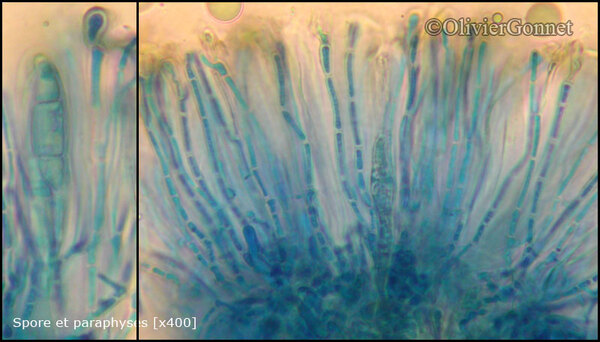
Courtesy Danièle et Olivier Gonnet - Source: https://www.afl-lichenologie.fr/Photos_AFL/Photos_AFL_P/Text_P_3/Polychidium_muscicola.htm
France, 4/11/2013 - Novacelles - sur Peltigera elisabethae établi sur mousse - Puy-de-Dôme
Growth form: Crustose
Substrata: soil, terricolous mosses, and plant debris
Photobiont: cyanobacteria, filamentous (e.g. Nostoc, Scytonema)
Reproductive strategy: mainly sexual
Most common in areas with a humid-warm climate (e.g. most of Tyrrenian Italy)
Commonnes-rarity: (info)
Alpine belt: absent
Subalpine belt: extremely rare
Oromediterranean belt: extremely rare
Montane belt: very rare
Submediterranean belt: extremely rare
Padanian area: absent
Humid submediterranean belt: very rare
Humid mediterranean belt: very rare
Dry mediterranean belt: absent

Predictive model
| Herbarium samples |


P.L. Nimis; Owner: Department of Life Sciences, University of Trieste
Herbarium: TSB (5166)
2001/11/28


P.L. Nimis; Owner: Department of Life Sciences, University of Trieste
Herbarium: TSB (5166)
2001/11/28


Curtis Randall Björk – CC BY-SA 4.0
British Columbia, Clearwater Valley Date: 2012-04-02 On basalt boulder in conifer-deciduous forest

Courtesy Danièle et Olivier Gonnet - Source: https://www.afl-lichenologie.fr/Photos_AFL/Photos_AFL_P/Text_P_3/Polychidium_muscicola.htm
France, 16/10/2012 - sur Grimmia - Quenza - Corse

Courtesy Danièle et Olivier Gonnet - Source: https://www.afl-lichenologie.fr/Photos_AFL/Photos_AFL_P/Text_P_3/Polychidium_muscicola.htm
France, 28/12/2014 - session FMBDS - Mont Cenis - Savoie

Courtesy Danièle et Olivier Gonnet - Source: https://www.afl-lichenologie.fr/Photos_AFL/Photos_AFL_P/Text_P_3/Polychidium_muscicola.htm
France, 4/11/2013 - Novacelles - sur Peltigera elisabethae établi sur mousse - Puy-de-Dôme

Courtesy Danièle et Olivier Gonnet - Source: https://www.afl-lichenologie.fr/Photos_AFL/Photos_AFL_P/Text_P_3/Polychidium_muscicola.htm
France, 4/11/2013 - Novacelles - sur Peltigera elisabethae établi sur mousse - Puy-de-Dôme

Courtesy Danièle et Olivier Gonnet - Source: https://www.afl-lichenologie.fr/Photos_AFL/Photos_AFL_P/Text_P_3/Polychidium_muscicola.htm
France, 4/11/2013 - Novacelles - sur Peltigera elisabethae établi sur mousse - Puy-de-Dôme

Courtesy Danièle et Olivier Gonnet - Source: https://www.afl-lichenologie.fr/Photos_AFL/Photos_AFL_P/Text_P_3/Polychidium_muscicola.htm
France, 4/11/2013 - Novacelles - sur Peltigera elisabethae établi sur mousse - Puy-de-Dôme

 INDEX FUNGORUM
INDEX FUNGORUM
 GBIF
GBIF
 DOLICHENS
DOLICHENS
